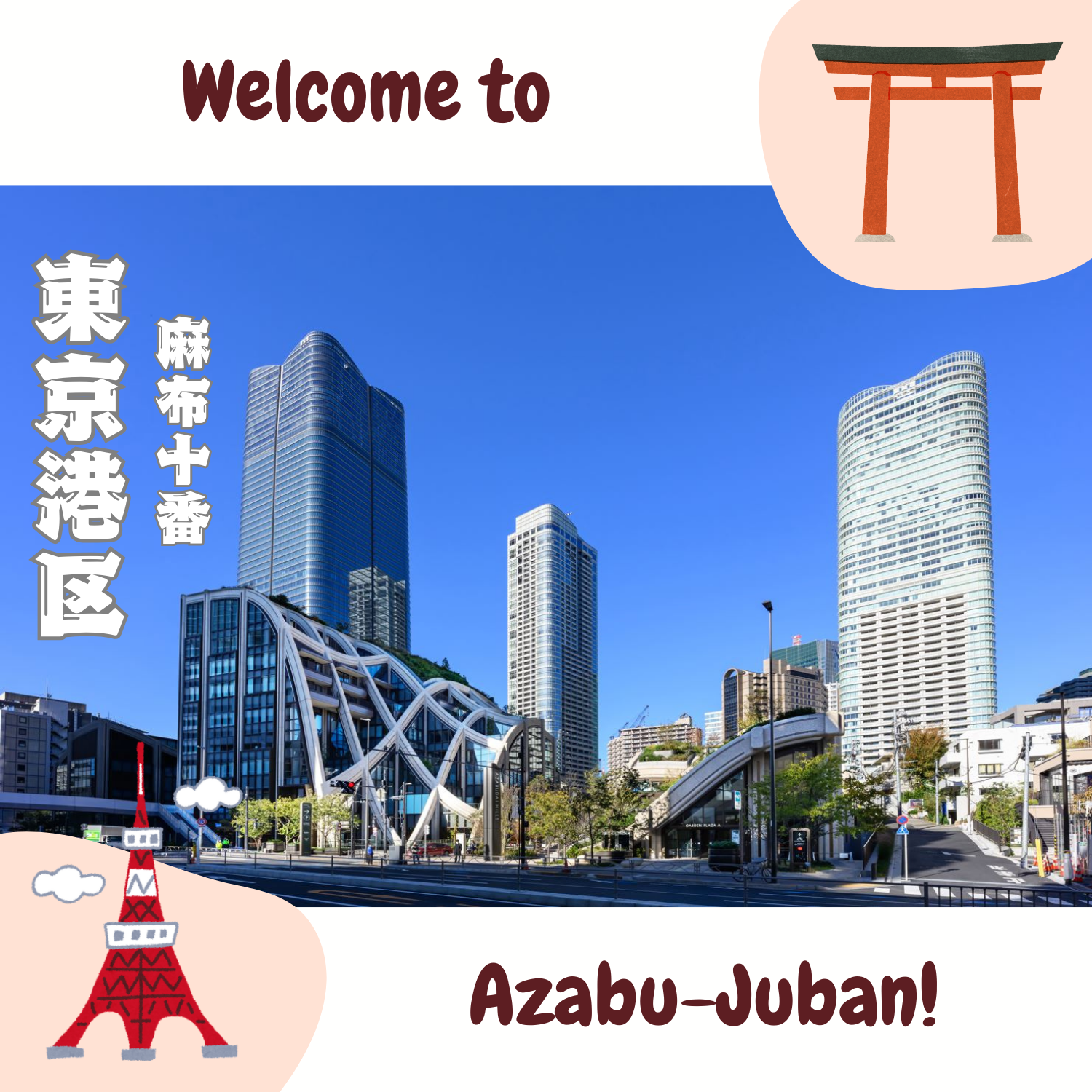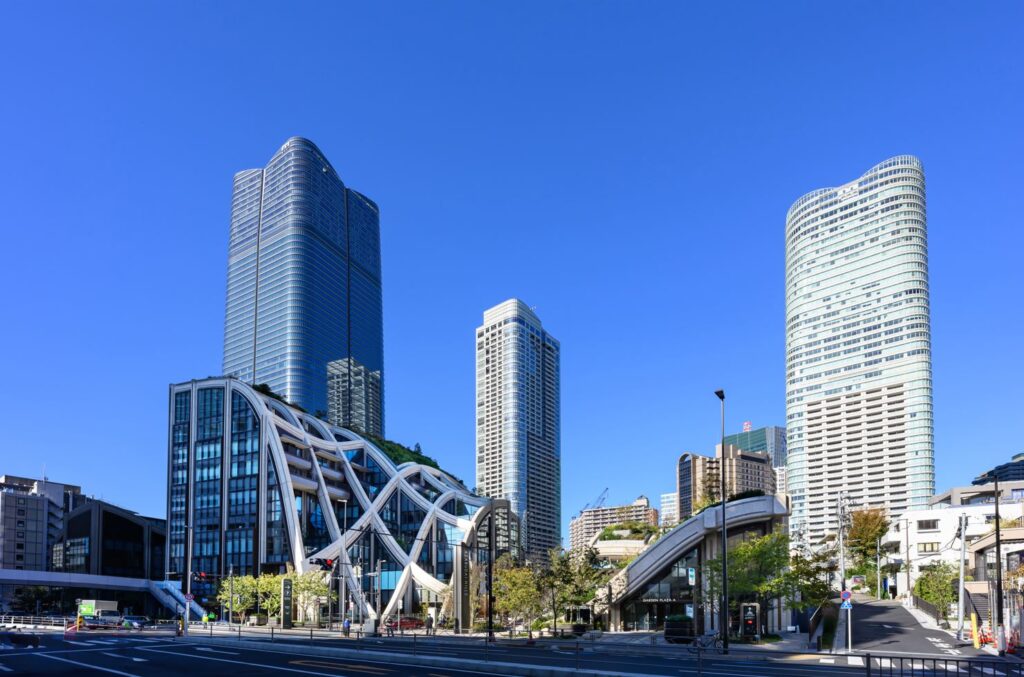
Azabu-Juban is a blend of modernity and tradition that has a lot to offer. With many options for food, shopping and entertainment, there is something to do for everyone. Let’s check it out!
Location
Azabu-Juban is located in Mintato-ku, Tokyo, one of the central districts of the city. Even though it is walking distance from popular locations like Roppongi and Tokyo Tower you might think this neighborhood is filled with crowds and noise. In reality, however, it is a relaxed and casual area. It’s a popular residential area, especially among international families, due to its central location and proximity to several international schools. Additionally, many families working at the numerous embassies in Minato-ku live in Azabu-Juban.
With direct access to the Tokyo Metro Namboku line and Toei Ōedo line, you can easily reach huge transportation hubs like Shibuya station and Shinjuku station within 15 minutes.
Azabu-Juban Shopping Street 商店街
Azabu-Juban’s Shotengai shopping street offers a great selection of restaurants, cafés, boutique shopping and more! With Azabu-Juban’s international popularity, you can find international grocery stores, and restaurants ranging from traditional Japanese dining like yakitori, ramen and izakaya-style food, to authentic Mexican cuisine, pizza and pasta, and more!
In the alleyways of the shotengai you can also sample food from small shops that sell traditional Japanese sweets. At Naniwaya you can try taiyaki – a pancake-like pastry filled with red bean paste. Established in 1909, Naniwaya is known for their fresh taiyaki and yakisoba – Japanese-style fried noodles – for take out. Many cafes offer select matcha on their menu that go well with Japanese sweets. On the other hand if you prefer salty food, stores like Mamegen and Agemochiya have a boasting collection of bean crackers and rice crackers in all kinds of flavors. For the adventurous eaters, why not try an exotic flavor, like pancetta or salted lemon.
What to do in Azabu-juban
Shopping
For everything from designer clothes and bags to furniture, Azabudai Hills can’t be missed. Azabudai Hills attracts shoppers seeking luxury, those interested in world class art galleries, and visitors to the teamLab Immersive Borderless digital art museum. On top of that you also have access to greenery and elegant restaurants and eateries.

Azabudai Hills was designed in a futuristic and unique way, encompassing the concept of “Green and Wellness” by combining living, working, and recreational activities in one area. The goal is to increase a sense of community and create a harmony between work and life.
Interesting fact: the Azabudai Hills Mori JP Tower stands at an impressive height of 325.5m making it one of Japan’s tallest buildings!
Spiritual Highlights – Temples and Shrines
If you want to catch a break from the hustle of the city, why not spend some time at a temple or shrine. The Azabu-Juban neighborhood hosts many small temples and shrines, where you can admire the traditional architecture and pray. A notable Buddhist temple is Azabusan Zenpukuji, which is rich in history and home to a more than 700-year old Ginkgo tree!
Azabu Hikawa Shrine is well known for its long history, dating back to the 16th century. The shrine is small and a fantastic example of how tradition blends with modernity in Azabu-Juban as several embassies surround the shrine.
Festivals
The Azabu-Juban Noryo Festival is a large and popular summer festival held annually in Azabu-Juban on the last weekend of August. The usually quiet shopping street transforms into a busy festival environment, with streets lined with festival stalls, with delicious festival food like pickled cucumbers with miso, grilled meats, yakisoba, cotton candy, and more! In addition to the food, there are traditional festival games like shateki pop-gun shooting games, kingyo sukui goldfish catching, and other games of skill and chance. Don’t miss out this great example of a traditional Japanese Omatsuri (festival).
Parks and Greenery
Directly across the street from Tutor Japan’s office is Ichi-no-hashi Park, a children’s playground featuring water fountains in the summer, a rock climbing wall, a long roller slide and plenty of benches for visitors to relax. As with most parks in Japan, a public restroom with a changing table is nearby as well, offering convenience for families of all ages. The park originally opened in 1953 and was renovated recently in 2024. With its proximate location to the Azabu Juban metro station the park is easily accessible.
Juban Inari and the かえる像
Are you intrigued by old legends or myths? The Gama Pond hidden among apartment buildings in Moto Azabu is listed as a cultural treasure by the city of Minato. The legend dates back to the Edo period and the pond was part of the estate property of a samurai of that time. During that time, a huge bullfrog was living in the pond and stopped a fire in that neighborhood with its icy breath, according to the legend. Due to the legend, the frogs still have special meaning in this area to this day. You can visit the Jūban-Inari Frogs inside the Jūban-Inari shrine.
Between Azabu-Juban and Hiro-o neighborhoods is Arisugawa-no-miya Memorial Park, which features winding walking paths, streams and water features, and the Tokyo Metropolitan Central Library. The park and its surrounding area is built on several tiers, increasing its overall size to 67,131 square meters. Many people also come here to enjoy leisure activities, such as playing baseball or tennis, and the park’s popular playgrounds. Come here to relax, or to enjoy some light exercise around the park’s trails and facilities!
